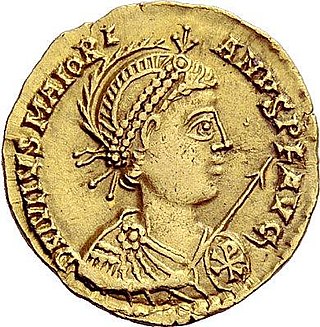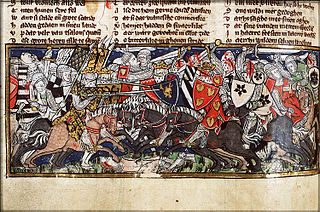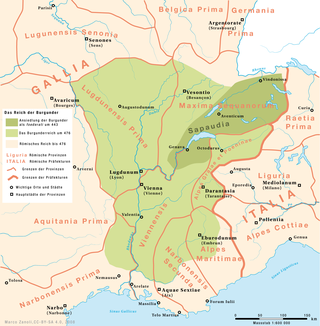
The Burgundians were an early Germanic tribe or group of tribes. They appeared in the middle Rhine region, near the Roman Empire, and were later moved into the empire, in eastern Gaul. They were possibly mentioned much earlier in the time of the Roman Empire as living in part of the region of Germania that is now part of Poland.
The 430s decade ran from January 1, 430, to December 31, 439.
The 480s decade ran from January 1, 480, to December 31, 489.
The 450s decade ran from January 1, 450, to December 31, 459.

Year 451 (CDLI) was a common year starting on Monday of the Julian calendar. At the time, it was known as the Year of the Consulship of Marcianus and Adelfius. The denomination 451 for this year has been used since the early medieval period, when the Anno Domini calendar era became the prevalent method in Europe for naming years.
The 440s decade ran from January 1, 440, to December 31, 449.

Year 456 (CDLVI) was a leap year starting on Sunday of the Julian calendar. At the time, it was known as the Year of the Consulship of Avitus without colleague. The denomination 456 for this year has been used since the early medieval period, when the Anno Domini calendar era became the prevalent method in Europe for naming years.

Year 458 (CDLVIII) was a common year starting on Wednesday of the Julian calendar. At the time, it was known as the Year of the Consulship of Maiorianus and Leo. The denomination 458 for this year has been used since the early medieval period, when the Anno Domini calendar era became the prevalent method in Europe for naming years.

Majorian was the western Roman emperor from 457 to 461. A prominent general of the Roman army, Majorian deposed Emperor Avitus in 457 and succeeded him. Majorian was the last emperor to make a concerted effort to restore the Western Roman Empire with its own forces. Possessing little more than Italy, Dalmatia, and some territory in northern Gaul, Majorian campaigned rigorously for three years against the Empire's enemies. His successors until the fall of the Empire, in 476–480, were actually instruments of their barbarian generals, or emperors chosen and controlled by the Eastern Roman court.

Aetius was a Roman general and statesman of the closing period of the Western Roman Empire. He was a military commander and the most influential man in the Empire for two decades (433–454). He managed policy in regard to the attacks of barbarian federates settled throughout the West. Notably, he mustered a large Roman and allied (foederati) army in the Battle of the Catalaunian Plains, ending a devastating invasion of Gaul by Attila in 451, though the Hun and his subjugated allies still managed to invade Italy the following year, an incursion best remembered for the ruthless Sack of Aquileia and the intercession of Pope Leo I.

The Battle of the Catalaunian Plains, also called the Battle of the Campus Mauriacus, Battle of Châlons, Battle of Troyes or the Battle of Maurica, took place on June 20, 451 AD, between a coalition – led by the Roman general Flavius Aetius and by the Visigothic king Theodoric I – against the Huns and their vassals – commanded by their king Attila. It proved one of the last major military operations of the Western Roman Empire, although Germanic foederati composed the majority of the coalition army. Whether the battle was of strategic significance is disputed; historians generally agree that the Siege of Orleans was the decisive moment in the campaign and stopped the Huns' attempt to advance any further into Roman territory or establish vassals in Roman Gaul. However, the Huns successfully looted and pillaged much of Gaul and crippled the military capacity of the Romans and Visigoths. Attila died only two years later, in 453; after the Battle of Nedao in 454, the coalition of the Huns and the incorporated Germanic vassals gradually disintegrated.
Aegidius was the ruler of the short-lived Kingdom of Soissons from 461 to 464/465 AD. Before his ascension, he became magister militum per Gallias serving under the Western Roman emperor Majorian, in 458. An ardent supporter of Majorian, Aegidius rebelled against General Ricimer when he assassinated Majorian and replaced him with Emperor Libius Severus. Aegidius may have pledged his allegiance to the Eastern Roman emperor Leo I the Thracian.

The Western Roman Empire comprised the western provinces of the Roman Empire at any time during which they were administered by a separate independent Imperial court; in particular, this term is used in historiography to describe the period from 395 to 476, where there were separate coequal courts dividing the governance of the empire in the Western and the Eastern provinces, with a distinct imperial succession in the separate courts. The terms Western Roman Empire and Eastern Roman Empire were coined in modern times to describe political entities that were de facto independent; contemporary Romans did not consider the Empire to have been split into two empires but viewed it as a single polity governed by two imperial courts as an administrative expediency. The Western Roman Empire collapsed in 476, and the Western imperial court in Ravenna was formally dissolved by Justinian in 554. The Eastern imperial court lasted until 1453.

This is a chronology of warfare between the Romans and various Germanic peoples between 113 BC and 476. The nature of these wars varied through time between Roman conquest, Germanic uprisings and later Germanic invasions of the Western Roman Empire that started in the late second century BC. The series of conflicts was one factor which led to the ultimate downfall of the Western Roman Empire in particular and ancient Rome in general in 476.
Placidia was a daughter of Valentinian III, Roman emperor of the West from 425 to 455, and from 454/455 the wife of Olybrius, who became western Roman emperor in 472. She was one of the last imperial spouses in the Roman west, during the Fall of the Western Roman Empire during Late Antiquity.

Roman Gaul refers to Gaul under provincial rule in the Roman Empire from the 1st century BC to the 5th century AD.
Kingdom of Burgundy was a name given to various states located in Western Europe during the Middle Ages. The historical Burgundy correlates with the border area of France and Switzerland and includes the major modern cities of Geneva and Lyon.

The Kingdom of the Burgundians or First Kingdom of Burgundy was established by Germanic Burgundians in the Rhineland and then in eastern Gaul in the 5th century.
The history of the Later Roman Empire covers the history of the Roman Empire from the beginning of the rule of Diocletian in 284 AD and the establishment of the Tetrarchy in 293 AD by Diocletian to the death of Heraclius in 641 AD.










